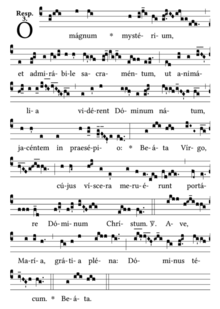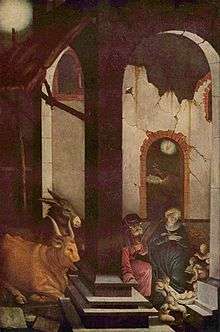O Magnum Mysterium


O Magnum Mysterium is a responsorial chant from the Matins of Christmas.
Text
- Latin text
- O magnum mysterium,
- et admirabile sacramentum,
- ut animalia viderent Dominum natum,
- iacentem in praesepio!
- Beata Virgo, cujus viscera
- meruerunt portare
- Dominum Iesum Christum.
- Alleluia!
- English translation
- O great mystery,
- and wonderful sacrament,
- that animals should see the new-born Lord,
- lying in a manger!
- Blessed is the Virgin whose womb
- was worthy to bear
- our Saviour, Jesus Christ.
- Alleluia!
History
The image of the oxen and donkey next to the crib is found in Isaiah (Isa. 1.3) and is traditionally related to the nativity scene at the birth of Jesus in Luke 2. Luke (Lk 2.7) does not mention animals, but a manger. In the apocryphal Gospel of Pseudo-Matthew, both animals are specifically named. The image continued to spread from the 13th century onwards when it was included in the Golden Legend. It became the most popular symbol for the mystery of the self-abasement of God in his Incarnation. (Phil 2,6-7).
The second part of the responsory relates to the words with which Elizabeth welcomes Mary, mother of Jesus on her visitation (Lk 1.42-43).
A great number of composers have reworked the chant into a contemporary setting; the settings by Byrd, Victoria,[1] Gombert, Gabrieli,[2] Palestrina,[3] Poulenc, Judith Bingham, Harbison, La Rocca, Mäntyjärvi, Pierre Villette, Morales, Lauridsen,[4][5] Busto, Louie, Maw, David Conte, Miskinis, Antognini,[6] Da Rold, Gjeilo,[7] Memley,[8] are notable.
References
- ↑ https://www.youtube.com/watch?v=5dn7HgiT2QY
- ↑ https://www.youtube.com/watch?v=KKRHj6ScI4k
- ↑ https://www.youtube.com/watch?v=D1QjkhENZg8
- ↑ https://www.youtube.com/watch?v=Jc6QxJQsceo
- ↑ https://www.youtube.com/watch?v=VIXQMTfnqCo
- ↑ https://www.youtube.com/watch?v=SXb-0gkSqGM
- ↑ https://www.youtube.com/watch?v=9Femr6-OMEM
- ↑ https://www.youtube.com/watch?v=9It0XnBMan8
External links
| Wikimedia Commons has media related to O magnum mysterium. |
- Free scores of O Magnum Mysterium in the Choral Public Domain Library (ChoralWiki)
- O Magnum Mysterium by Grex Vocalis
- Magnum Mysterium by Morten Lauridsen
- Magnum Mysterium by Morten Lauridsen Sung by Lumen Valo
- Magnum Mysterium by Tomas Victoria
- Magnum Mysterium by Gabrieli
- Magnum Mysterium by Jennifer Higdon
- Magnum Mysterium by Carl Rütti
- Magnum Mysterium by Giovanni Pierluigi da Palestrina
- Magnum Mysterium by Jan Dismas Zelenka
- Magnum Mysterium by Margaret Rizza
- Magnum Mysterium by Ivo Antognini
- Magnum Mysterium by Manolo Da Rold
- Magnum Mysterium (Serenity) by Ola Gjeilo
- O Magnum Mysterium by Chris Artley
- O Magnum Mysterium by Kevin Memley